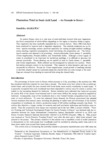Plantation Trial in Semi-Arid Land -An Example in Kenya-
JIRCAS international symposium series
| ISSN | 13406108 |
|---|---|
| 書誌レコードID(総合目録DB) | AA1100908X |

本文フルテキスト
intlsymp-1_140-146.pdf237.42 KB
In eastern Kenya, there is a vast area of semi-arid land covered with poor vegetation, the floral composition of which differs depending on the region or location within a region. This vegetation has been markedly degraded due to various factors. Since 1986 trials have been conducted to improve such a degraded vegetation. The methods employed are as follows: species screening, nursery practices especially for raising drought-resistant seedlings, stump planting, vegetative propagation, water harvesting, site preparation, etc. The following six species were deemed to be promising : Acacia polyacantha, Cassia siamea, C. spectabilis,Croton megalocarpus, Prosopis julijlora, and Tamarindus indica. Although a lower supply of water is considered to be important for hardening seedlings, it is difficult to decrease the amount practically. Stump planting can be applied at least to Cassia siamea, C. spectabilis, and Croton megalocarpus. Melia volkensii can be propagated by induced root suckers. Water harvesting attempts remain to be evaluated. This measure is labor-intensive and may not necessarily be effective. Except for Croton megalocarpus, sound growth of seedlings planted in the belts cleared cannot be confirmed unless the cleared belts are wide enough or the seedlings are released from shading by reserved belts along the cleared belts.
| 作成者 | Sumihiko ASAKAWA |
|---|---|
| 公開者 | Japan International Research Center for Agricultural Sciences |
| オンライン掲載日 | |
| 号 | 1 |
| 開始ページ | 140 |
| 終了ページ | 146 |
| 言語 | eng |
